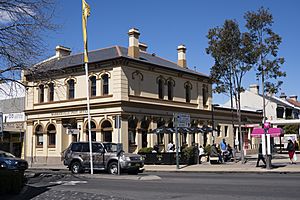Marrickville Post Office facts for kids
Quick facts for kids Marrickville Post Office |
|
|---|---|

Marrickville Post Office, 2017
|
|
| Location | 274A Marrickville Road, Marrickville, Sydney, New South Wales, Australia |
| Official name: Marrickville Post Office | |
| Type | Listed place (Historic) |
| Designated | 22 August 2012 |
| Reference no. | 106204 |
| Builders | Messrs Graham and Mercer |
| Lua error in Module:Location_map at line 420: attempt to index field 'wikibase' (a nil value). | |
The Marrickville Post Office is an old building in Marrickville, Sydney, Australia. It's located at 274A Marrickville Road. This building is special because it's listed on the Australian Commonwealth Heritage List. This means it's an important part of Australia's history and should be protected. It was added to this list on 22 August 2012.
Contents
The Story of Marrickville Post Office
The Marrickville Post Office was built a long time ago, in 1891. It cost £2,197 to build, which was a lot of money back then! The builders were a company called Messrs Graham and Mercer. It officially opened its doors in April 1891.
This post office was built in this spot because the area was becoming a busy business centre. A tram line was built along Marrickville Road in 1881. This made the area easy to get to, so more shops and businesses opened there.
What the Building Was Used For
When it first opened, the building had a few different uses. It was a post office where people could send letters and parcels. It also had a telegraph office for sending quick messages. Plus, there was a home for the postmaster and their family inside the building.
Over the years, the building has changed. Around 1960, some big changes were made to the back part of the building. Today, the main post office services are located towards the back. The front part of the building, which used to be the main postal hall, is now a café!
What the Building Looks Like
The Marrickville Post Office is on the corner of Marrickville Road and Silver Street. It's a two-storey building, meaning it has two main levels.
Outside the Building
The front of the building, facing Marrickville Road, has a classic look. It has tall, flat columns called pilasters on each side of the main entrance. There are also arched windows on both the ground floor and the first floor.
The side of the building, facing Silver Street, also has two entrances. It has a similar style with arched windows. You might notice that the roof has special decorative supports called brackets. These brackets are placed in different ways to match the windows below.
Inside the Building
A single-storey part was added to the back of the building later on. In the 1990s, the building was changed so that both Australia Post and a café could use it.
- The café now uses most of the ground floor of the two-storey part. This area has tables for dining, a kitchen, and toilets.
- You can still see two old iron columns with fancy tops in the café area. These columns are thought to be original from when it was first built as a post office.
- Australia Post now runs its services from the single-storey part at the back.
- Upstairs, there's a lunchroom, storage areas, and toilets for Australia Post staff. The upstairs area still looks a lot like it did originally.
Key Features to Notice
When you look at the Marrickville Post Office, here are some important parts:
- The outside walls facing Marrickville Road and Silver Street.
- The old postal hall area, especially the iron columns inside the café.
- The original timber staircase.
Why It's a Heritage Building
The Marrickville Post Office is important enough to be on the Australian Commonwealth Heritage List. This is because it meets several special requirements.
Its Role in History
This post office has been a key building for almost 120 years. It shows how Marrickville grew and how this area became the main business centre after the tram line was built. It's also one of the last buildings designed by a famous architect named James Barnet.
Its Unique Style
The Marrickville Post Office is a great example of a late 19th-century post office. It's built in a style called Italianate, which was popular at the time. This style often includes features like arches, columns, and decorative details.
Even though it's a post office, its design makes it look a bit like an old bank. This helped it fit in with the other shops and buildings on Marrickville Road. The building has kept much of its original look, especially on the outside.
Designed by a Famous Architect
The Marrickville Post Office is special because it's linked to James Barnet. He was a very busy and important architect who designed many post offices in Australia. This building is thought to be one of the last ones he designed before a new government architect took over.
Images for kids


